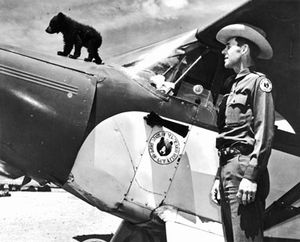Smokey Bear sparked legacy of fire prevention art
PUBLIC LANDS -- The legacy of Smokey Bear is celebrating its 70th anniversary of fire prevention messages this year.
The campaign's roots date back to 1942, when the U.S. Forest Service’s popular icon of wildfire prevention was conceived during World War II to publicize the need to protect a critical natural resource—wood. The first artist’s rendering of Smokey was created by Albert Staehle in 1944.
The ad campaign: "Remember... Only YOU Can Prevent Forest Fires", was created in 1947 by The Advertising Council.
The ad campaign got a flesh and blood boost starting in 1950, when firefighters working a blaze in New Mexico's Capitan Mountains came back to camp packing an orphaned six-week-old black bear cub with singed hair and burned feet.
Ray Bell, a state Game and Fish Department ranger and pilot, flew the bear to a veterinarian in Santa Fe for initial treatment and then took the cub home, where his wife and daughter helped him nurse the bear back to health over two months. Initially, they had to get the cub to suck a mixture of honey, milk and baby food from their fingers.
The cub originally was named "Hot Foot Teddy," but U.S. Forest Service officials saw the potential for news about the cub to translate into a hot campaign for forest fire prevention. They renamed the bear Smokey.
The cub was taken to the National Zoo in Washington, D.C., later that summer, where he became an instant celebrity as he grew into a 400-pound bear. Smokey lived there for 26 years before his death in 1976.
While preventing forest fires continues to be a noble cause, the Forest Service in recent years has had to come to terms with over-protection of some forest areas. Education efforts have expanded to showing that that fire suppression in some cases can let fuels build up on forests to a degree that a fire sparked by humans or nature can blow up to catastrophic proportions.
- The goal and theme of the Smokey Bear campaign was adjusted in the last decade, from "Only you can prevent forest fires" to "Only you can prevent wildfires." The purpose is to respond to the criticism, and to distinguish 'bad' intentional or accidental wildfires from the needs of sustainable forests via natural 'good' fire ecology.
Meanwhile, the 70 years of Smokey Bear campaign created a legacy of artwork, some of which can be viewed online. Federal land agencies and Firewise are producing an exhibit of Rudy Wendelin’s famous Smokey Bear prints at the Idaho Capitol Building in Boise through June.
Wendelin worked for the US Forest Service from 1949-1973 and took the approach to “soften & humanize” the appearance of Smokey Bear to gain the attention of children. This method was successful in helping spread the fire education message “Only You Can Prevent Wildfires.”
x x

